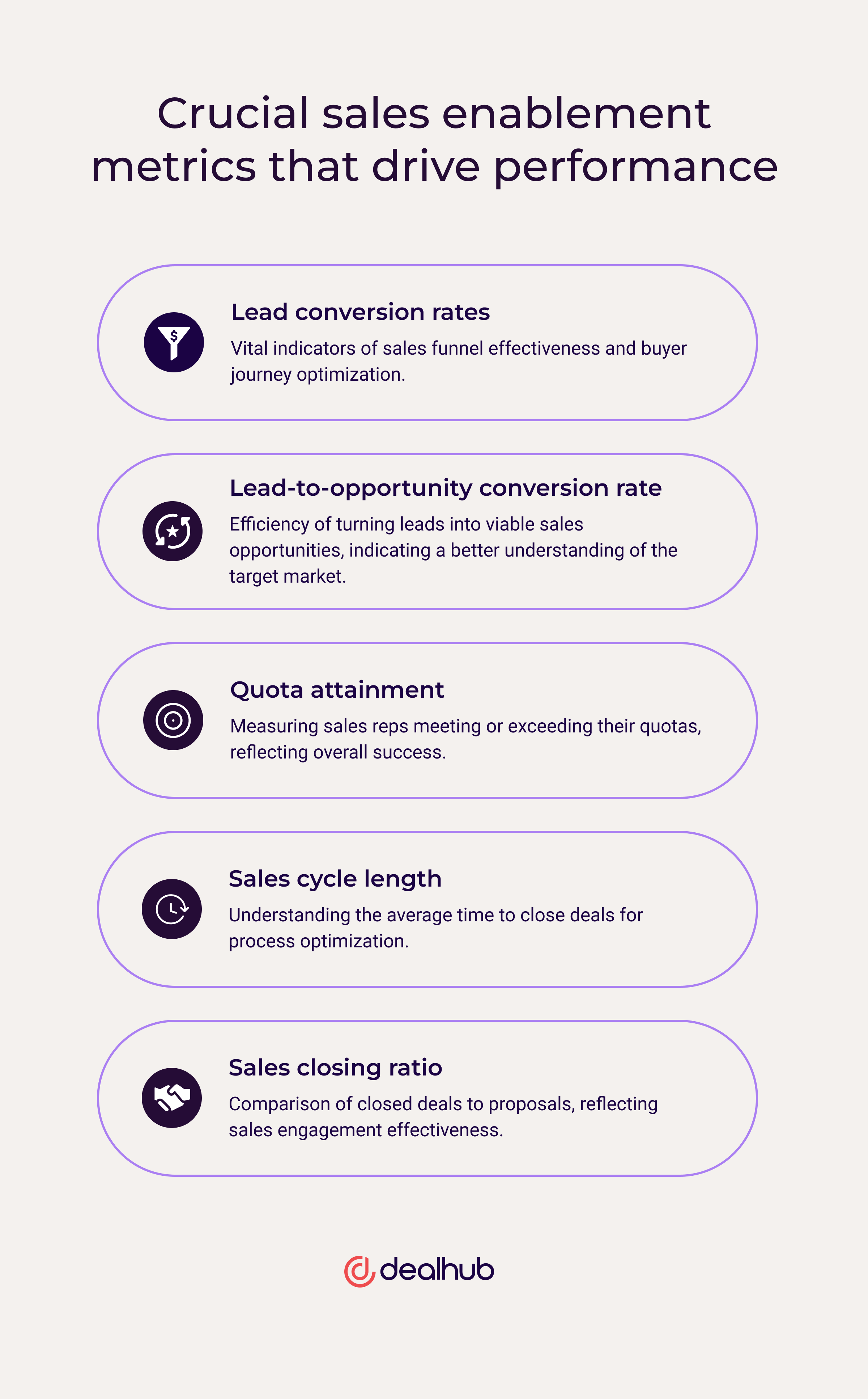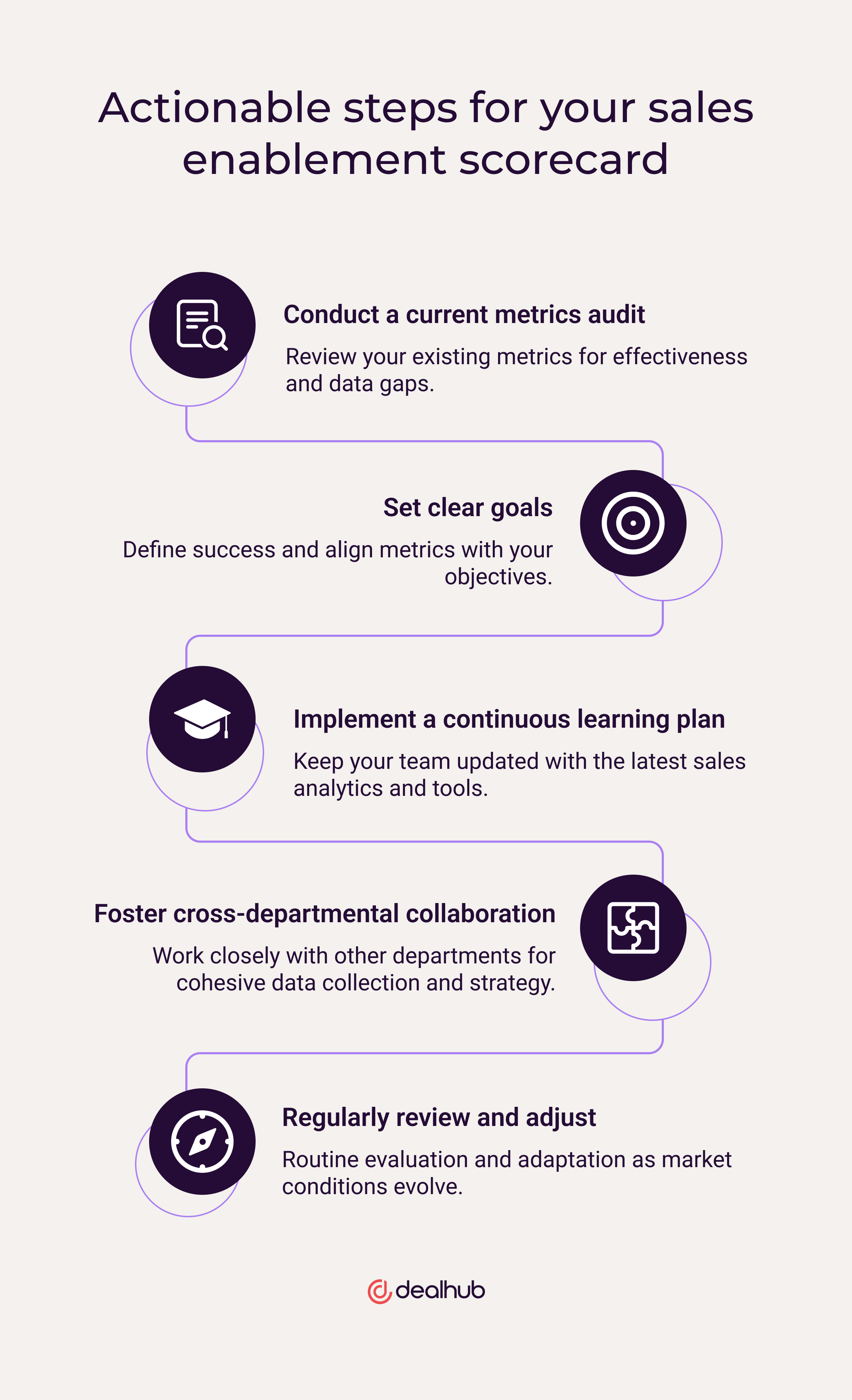Below, we explore how Sales Operations leaders shape a successful sales enablement strategy and the critical metrics they employ for driving revenue growth and making informed decisions.
Setting the stage for sales success
Sales Operations is pivotal in formulating a sales enablement strategy that empowers teams and enhances sales effectiveness. This strategy involves multiple components, each uniquely aligning sales efforts with the company’s objectives.
Content development and management
Content development and management are critical to an effective sales strategy.
Content creation
Crafting high-quality content that resonates with buyers at different stages of the sales funnel requires understanding customer needs, industry specifics, and the nuances of the sales process. The content should attract, educate, and persuade prospects, leading them closer to a purchasing decision. Creating effective content requires creativity, market insight, and a deep understanding of the company’s offerings.
Content organization
A systematic approach to organizing and categorizing content ensures that sales representatives can access the right materials at the right time. This system might include tagging content by stage in the sales cycle, product line, or customer industry. The goal is to streamline the search process, making it quick and intuitive for sales teams to find and utilize the most relevant and impactful content.
Training and development
Enhancing the skills and knowledge of sales teams through targeted training and structured onboarding lays the foundation for sustained sales excellence.
Sales training programs
Continuous learning in the fast-evolving sales environment helps sales professionals stay on top of their game. Training programs should cover a wide range of topics, including product knowledge, industry trends, objection handling, and effective communication strategies. Companies can enhance their overall sales effectiveness and adaptability to changing market conditions by ensuring that sales teams are well-informed and skilled.
Onboarding processes
A well-structured onboarding process helps new hires integrate into the sales team and equips them with the necessary knowledge and skills to perform their roles effectively. Onboarding should be seen as an ongoing process, with regular check-ins and support to ensure new representatives are assimilating well and reaching their full potential quickly.
Technology integration
The next step is integrating advanced tools and platforms that can streamline processes and enhance the efficiency of sales operations.
CRM systems
Integrating and optimizing Customer Relationship Management (CRM) tools enhances direct customer engagement and streamlines the sales process. CRM systems serve as a primary interface for sales reps, offering immediate access to customer history and personalizing the sales approach.
Sales enablement platforms
Investing in sales enablement platforms can significantly boost sales effectiveness. These platforms often provide solutions for content management, training, sales quote and proposal generation, and analytics. They serve as a central hub for sales resources, offering tools for content distribution, performance tracking, and collaboration, thus enhancing the overall efficiency and impact of the sales team.
Sales and marketing alignment
Effective sales strategies don’t operate in a vacuum. Strategic collaboration and processes ensure a unified approach between sales and marketing teams for optimal results.
Collaboration
Collaboration between the sales and marketing teams helps both teams maintain consistent messaging and strategic alignment. Regular communication and joint strategy sessions can ensure that both teams work toward the same goals with a unified approach.
Lead handoff
Establishing a seamless lead handoff process creates momentum in the sales cycle. This process involves setting clear criteria for lead qualification and ensuring a smooth transition from marketing to sales. A well-defined handoff process helps maintain the lead’s interest and ensures that sales representatives have all the necessary information to effectively engage and convert prospects.
Performance measurement and analytics
Measuring sales enablement success helps sales managers develop programs to improve enablement programs. Metrics and analytical tools provide insights into the effectiveness of sales strategies and inform decision-making.
Key performance indicators (KPIs)
Identifying and tracking the right KPIs helps Sales Ops determine the effectiveness of sales enablement efforts. Relevant sales KPIs include lead conversion rates, win/loss ratios, and the sales cycle length. These metrics help measure success and can guide strategic adjustments.
Data analysis
Utilizing analytics tools provides deeper insights into customer behavior, sales trends, and the effectiveness of various initiatives. Data analysis can help identify patterns, forecast outcomes, and make informed decisions to enhance sales performance. It’s not just about collecting data but transforming it into actionable intelligence that can drive sales enablement strategy forward.
Crucial sales enablement metrics that drive performance
To truly understand the impact of our strategies let’s dive into the sales enablement metrics that drive performance.

Lead conversion rates
Lead conversion rates are vital indicators of sales funnel effectiveness and buyer journey optimization. They clearly show how effectively potential customers are being converted into actual sales opportunities.
Lead-to-opportunity conversion rate
This metric reveals the efficiency of the sales process in turning leads into viable sales opportunities. A higher rate indicates a more effective sales strategy and a better understanding of the target market.
Quota attainment
Measuring the percentage of sales representatives meeting or exceeding their sales quotas reflects the overall success of the sales enablement strategy. It indicates the team’s ability to capitalize on opportunities and close deals.
Sales cycle length
Understanding the average time it takes to close a deal helps sales managers determine where progress can be made. A shorter sales cycle often means a more efficient sales process, while a longer cycle might indicate areas needing improvement, such as lead qualification or quote approvals.
Sales closing ratio
This ratio compares the number of deals closed to the number of proposals given. A higher closing ratio suggests that sales representatives effectively engage prospects and successfully navigate them through the sales funnel.
Content engagement metrics
Sales leaders can analyze the impact of sales content to understand its effectiveness and refine their strategy. Utilizing platforms that track user interactions, assess content performance, and visualize data can help form a comprehensive understanding of content’s impact. Important metrics include the following:
Conversion rate
This metric helps gauge how compelling sales and marketing content is. It measures the percentage of users who take a desired action after engaging with the content, indicating its ability to motivate prospects towards the next step in the sales process.
Lead generation
Tracking the number and quality of sales leads generated by content helps assess its effectiveness in attracting potential customers. High-performing content not only draws more leads but also ensures they are of good quality and more likely to convert.
Pipeline influence
Evaluating content’s role in moving leads through the sales pipeline provides insights into which materials are most effective at different stages. Understanding this influence helps optimize the content strategy to support sales progression effectively.
Revenue attribution
Connecting specific content pieces to generated revenue allows businesses to identify which assets are truly driving sales. The revenue attribution metric highlights the direct financial impact of content and helps prioritize types of content that contribute most to the bottom line.
Customer retention
Measuring how content affects customer satisfaction and retention is key. Engaging, valuable content can help nurture customer relationships, encourage repeat business, and foster brand loyalty.
Sales training effectiveness
Effectively measuring the impact of sales training programs ensures that teams are well-equipped and efficient.
Ramp time or time to first deal
This metric indicates the average time a new sales representative takes to close their first deal. Shorter ramp times suggest more effective training and quicker adaptation to the sales environment.
Training completion percentage scores
Tracking the percentage of training modules or courses completed by representatives provides insight into their engagement and dedication to learning. High completion rates often correlate with better performance and understanding of the sales process.
Sales process adherence
Measuring how well sales representatives follow the prescribed sales process can indicate the effectiveness of training. Tools that monitor sales activities and milestones can provide valuable data on adherence rates, highlighting areas where additional training may be needed to improve compliance and performance.
Emerging metrics
As sales enablement evolves, several emerging metrics are gaining prominence for their insights into sales performance and organizational health.
Customer churn rate
Churn rate represents the percentage of customers who terminate their contracts within a specific time frame. A lower churn rate suggests higher customer satisfaction and loyalty, often reflecting the effectiveness of post-sale support and engagement strategies.
Employee net promoter score (eNPS)
eNPS measures employee satisfaction and loyalty, providing insights into the internal environment and its impact on sales performance. Higher scores typically correlate with more motivated and productive sales teams.
Conversation to close ratio
This metric tracks the number of conversations or interactions needed to close a deal. It helps Sales Ops managers understand the efficiency of sales conversations and identify the effectiveness of sales training and methodologies.
Available selling time
Measuring the actual time sales representatives spend selling versus performing administrative tasks can spotlight inefficiencies and potential areas for process optimization.
Sales velocity
Sales velocity, or time to revenue, assesses how quickly leads move through the pipeline and generate revenue. This metric combines several factors, including lead conversion rates and deal size, to provide a comprehensive view of sales efficiency and effectiveness.
Sales enablement analytics tools to empower Sales Ops
Analytics tools and dashboards are indispensable for Sales Operations, providing the insights needed to measure and enhance sales performance effectively.
CRM integration for seamless metrics tracking
Integrating analytics with CRM systems allows for real-time tracking of sales activities and customer interactions. This seamless integration ensures that every aspect of the sales process is monitored and analyzed for continuous improvement.
AI-powered analytics platforms
AI-driven platforms offer advanced analysis, predicting trends and providing deeper insights into sales performance. They help Sales Ops understand complex patterns and make informed decisions.
Customized dashboards for quick insights
Customized dashboards allow Sales Ops to have immediate access to the most relevant metrics, tailored to their specific needs. This enables quick assessment and response to emerging sales trends.
Mobile accessibility for on-the-go monitoring
With mobile-accessible analytics, Sales Ops teams can monitor performance anytime, anywhere, ensuring they’re always informed and ready to act on the latest data.
Metrics are elevating Sales Operations
The integration of key sales enablement metrics has significantly transformed Sales Operations, shifting it from a supportive to a strategic role. Metrics such as lead conversion rates, sales cycle lengths, content engagement, and employee net promoter scores provide a comprehensive view of the sales ecosystem. They enable Sales Operations to demonstrate the tangible impact of tools, processes, and personnel on the organization’s sales function.
These metrics quantify sales strategies’ effectiveness and highlight improvement and innovation areas. By tracking the right KPIs, Sales Operations can make data-driven decisions, tailor strategies to meet market demands, and enhance overall sales performance. The ability to analyze and act on this data ensures that Sales Ops is continuously aligning sales efforts with organizational goals and adapting to the dynamic sales environment.
For Sales Ops leaders aiming to harness the full potential of sales enablement analytics, consider the following actionable steps for your sales enablement scorecard:

- Conduct a current metrics audit: Review the metrics you currently track. Are they providing the insights you need? Are there gaps in the data you’re collecting?
- Set clear goals: Define what success looks like for your team and organization. Align your metrics with these goals to ensure they’re driving the desired outcomes.
- Implement a continuous learning plan: Keep your team updated with the latest in sales analytics and tools. Encourage the cultivation of a culture that emphasizes continuous learning and adaptation.
- Foster cross-departmental collaboration: Work closely with other departments, especially marketing and IT, to ensure a cohesive data collection and strategy implementation approach.
- Regularly review and adjust: Make it a routine to review the effectiveness of your metrics and strategies. Be prepared to adjust as market conditions and organizational needs evolve.
By actively engaging with these steps, Sales Ops leaders can not only observe but also significantly amplify their organization’s sales achievements. The future of sales is data-driven, and the time to embrace this shift is now. Leverage these metrics to accelerate your organization’s trajectory toward sustained sales excellence.
Sales enablement metrics as a catalyst for change
Sales Operations can leverage sales enablement metrics as a powerful catalyst for change. By harnessing data from various tools and platforms, Sales Ops leaders gain actionable insights into their sales process, customer behavior, and team performance. These insights allow them to identify areas for improvement, advocate for necessary resources or changes, and measure the impact of their strategies.
Demonstrating the tangible benefits of sales enablement initiatives through solid metrics helps Sales Operations position itself as a strategic driver of growth and efficiency within the organization. This shift empowers Sales Ops to implement rapid, data-driven decisions, enhancing its role as a bridge between strategic vision and practical execution.





